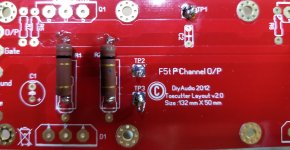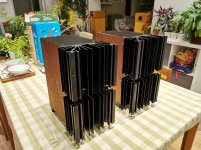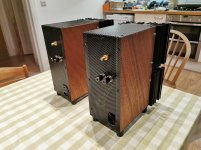they dont have version 1Diyaudio store got some:
F-5T – diyAudio Store
they dont have version 1
drop the MUR diodes and a V2 becomes V1.
With the pandemic keeping me stuck at home, I cleaned the garage sort of, and I found several boxes labeled Pass F5 Turbo. I have moved them at least 4 times. So I started building it and got the case, power supply and FE board working as intended I think. The problem so far is I have older boards and they no longer correspond with the BOM. Or, and this is entirely possible, I am becoming demented. The output board has Toecutter V 2.0 on it and I am uncertain about R 5, 6, and 7. Any help would be greatly appreciated.


With the pandemic keeping me stuck at home, I cleaned the garage sort of, and I found several boxes labeled Pass F5 Turbo. I have moved them at least 4 times. So I started building it and got the case, power supply and FE board working as intended I think. The problem so far is I have older boards and they no longer correspond with the BOM. Or, and this is entirely possible, I am becoming demented. The output board has Toecutter V 2.0 on it and I am uncertain about R 5, 6, and 7. Any help would be greatly appreciated.
View attachment 861735
Try the attached BOM.
Rush
Attachments
Before I go any further, I was wondering if there is a consensus on whether to use separate heat sinks for the MUR3020 diodes, or to put them on the main heat sinks? Do they even get hot? My F5 gets up to about 55 C. in the garage, (no AC, 35C in the summer). The Turbo will probably run about the same. It has 4 times the heat sink per channel. Thank you for your assistance.
I built a set of V3 F5 monoblocks. I did not install the diodes. When I did the calculations for the increase in power it was not enough to justify the expense and risk. The increase in power is less for average speaker loads as you put more output fets in parallel.
If you install them you have an upper limit for your bias current that needs to be respected.
If you install them you have an upper limit for your bias current that needs to be respected.
As long as you have enough air arond the chassis, yes.
It should be open on the sides. And around 4" on top.
I assume that N parts will go to one heatsink and P to the other.
I'm wondering if for some reason there is asymmetry in cooling (e.g. opened window cools better one side), will it cause some unexpected side-effects e.g. DC offset drift?
I built a set of V3 F5 monoblocks. I did not install the diodes. When I did the calculations for the increase in power it was not enough to justify the expense and risk. The increase in power is less for average speaker loads as you put more output fets in parallel.
If you install them you have an upper limit for your bias current that needs to be respected.
+1
AudioSan, Thank you for your reply. $50 worth of little heat sinks and a bunch of diodes for sale cheap. Rats! I have been rereading this from the beginning and am at about page 500. Reading it is making me cross eyed. I remember seeing where Buzzforb ditched the diodes, and was thinking he changed the 1 Ohm resistors to a different value? I have searched but have not found that post.
Have anyone purchased F5T V1/V2 transistor kit and use them for V3 instead. I have to buy 2 kits if it works out.
F-5T V1/2 Transistor Kit – diyAudio Store
If not, anyone can recommend a good seller for matched mosfet. I saw some on eBay but not too sure of the seller.
Regards,
Rob
F-5T V1/2 Transistor Kit – diyAudio Store
If not, anyone can recommend a good seller for matched mosfet. I saw some on eBay but not too sure of the seller.
Regards,
Rob
Have anyone purchased F5T V1/V2 transistor kit and use them for V3 instead. I have to buy 2 kits if it works out.
F-5T V1/2 Transistor Kit – diyAudio Store
If not, anyone can recommend a good seller for matched mosfet. I saw some on eBay but not too sure of the seller.
Regards,
Rob
you need matched quads outputs for V3. not matched pairs.
- Home
- Amplifiers
- Pass Labs
- F5 Turbo Builders Thread

